Birds in the News #31
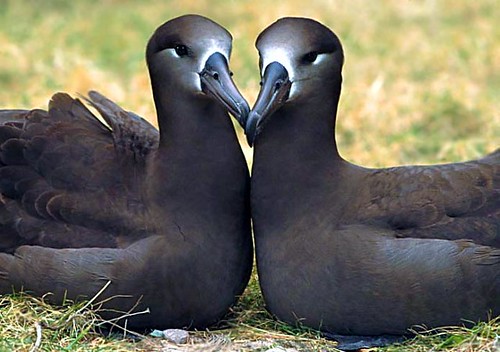
Endangered Black-footed Albatross, Phoebastria nigripes
Birds in Science
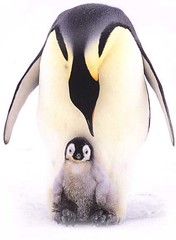 Penguins are some of the most improbable animals on the planet. They have wings and feathers but cannot fly. They are not fish, but they have been recorded as deep as 1,755 feet underwater. And the most improbable is the emperor penguin, Aptenodytes forsteri (pictured), which waddles across 70 miles of Antarctic ice to reach its breeding grounds. New research on penguin DNA suggests that the emperor also has the most ancient lineage of living penguins. Scientists have long recognized a link from penguins to petrels and albatrosses. While albatrosses have more conventional bird bodies, they share subtle traits with penguins, like the arrangement of beak bones. They are generally considered the closest living relatives of penguins. The researchers, based at the Royal Ontario Museum, concluded that penguins diverged from the ancestors of petrels and albatrosses about 71 million years ago. It's possible that the earliest penguins resembled petrels, which have short wings that help them dive as far as 240 feet underwater. Over time, penguins may have become more adapted to diving. "That required sacrificing flight," Norberto Giannini, a biologist at the American Museum of Natural History, speculated. The study also finds that the living species that belong to the oldest branches of the penguin tree - the gentoo, chinstrap and king penguins, along with the emperor penguins - can all be found around Antarctica. "The ancestor of the modern penguins were in Antarctica or very close," said Dr. Pereira. This paper was recently published in the respected peer-reviewed journal, The Proceedings of the Royal Society of London.
Penguins are some of the most improbable animals on the planet. They have wings and feathers but cannot fly. They are not fish, but they have been recorded as deep as 1,755 feet underwater. And the most improbable is the emperor penguin, Aptenodytes forsteri (pictured), which waddles across 70 miles of Antarctic ice to reach its breeding grounds. New research on penguin DNA suggests that the emperor also has the most ancient lineage of living penguins. Scientists have long recognized a link from penguins to petrels and albatrosses. While albatrosses have more conventional bird bodies, they share subtle traits with penguins, like the arrangement of beak bones. They are generally considered the closest living relatives of penguins. The researchers, based at the Royal Ontario Museum, concluded that penguins diverged from the ancestors of petrels and albatrosses about 71 million years ago. It's possible that the earliest penguins resembled petrels, which have short wings that help them dive as far as 240 feet underwater. Over time, penguins may have become more adapted to diving. "That required sacrificing flight," Norberto Giannini, a biologist at the American Museum of Natural History, speculated. The study also finds that the living species that belong to the oldest branches of the penguin tree - the gentoo, chinstrap and king penguins, along with the emperor penguins - can all be found around Antarctica. "The ancestor of the modern penguins were in Antarctica or very close," said Dr. Pereira. This paper was recently published in the respected peer-reviewed journal, The Proceedings of the Royal Society of London.The recent discovery of a 90-million-year-old dinosaur in Patagonia demonstrates that dromaeosaurs, a group of carnivorous theropods that includes Velociraptor and is closely related to birds, originated much earlier than previously thought. Rather than originating during the Cretaceous, dromaeosaurs can now be traced back to the Jurassic, possibly as far back as 180 million years ago. Meanwhile, the new dinosaur's birdlike features -- its huge, hollow wishbone; long, winglike forelimbs; and bird-like pelvis -- provide more evidence linking dinosaurs to birds.
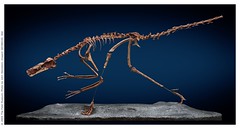 Buitreraptor (bwee-tree-rap-tor) gonzalezorum (pictured) is approximately the size of a very large rooster, but with a long head and very long tail. It is the most complete small theropod (carnivorous dinosaur) ever discovered in South America. It is described in the October 13 cover story for the top-tier scientific journal, Nature. It was excavated last year by a team of Argentine and American paleontologists, including Peter Makovicky, curator of dinosaurs at The Field Museum. "Buitreraptor is one of those special fossils that tells a bigger story about the Earth's history and the timing of evolutionary events," says Makovicky, lead author of the Nature paper. "It not only provides definitive evidence for a more global distribution and a longer history for dromaeosaurs than was previously known, but also suggests that dromaeosaurs on northern and southern continents took different evolutionary routes after the landmasses they occupied drifted apart."
Buitreraptor (bwee-tree-rap-tor) gonzalezorum (pictured) is approximately the size of a very large rooster, but with a long head and very long tail. It is the most complete small theropod (carnivorous dinosaur) ever discovered in South America. It is described in the October 13 cover story for the top-tier scientific journal, Nature. It was excavated last year by a team of Argentine and American paleontologists, including Peter Makovicky, curator of dinosaurs at The Field Museum. "Buitreraptor is one of those special fossils that tells a bigger story about the Earth's history and the timing of evolutionary events," says Makovicky, lead author of the Nature paper. "It not only provides definitive evidence for a more global distribution and a longer history for dromaeosaurs than was previously known, but also suggests that dromaeosaurs on northern and southern continents took different evolutionary routes after the landmasses they occupied drifted apart." In contrast to the previous story .. Dr. Alan Feduccia of the University of North Carolina at Chapel Hill, and a team of scientists says that as a result of their new research and other studies, continuing, exaggerated controversies over "feathered dinosaurs" make no sense. No good evidence exists that fossilized structures found in China and which some paleontologists claim are the earliest known rudimentary feathers were really feathers at all, Feduccia says. Instead, the fossilized patterns appear to be bits of decomposed skin and supporting tissues that just happen to resemble feathers to a modest degree. "We all agree that birds and dinosaurs had some reptilian ancestors in common," said Feduccia, professor of biology in UNC’s College of Arts and Sciences. "But to say dinosaurs were the ancestors of the modern birds we see flying around outside today because we would like them to be is a big mistake. The theory that birds are the equivalent of living dinosaurs and that dinosaurs were feathered is so full of holes that the creationists have jumped all over it, using the evolutionary nonsense of ‘dinosaurian science’ as evidence against the theory of evolution," he said. "To paraphrase one such individual, ‘This isn’t science . . . This is comic relief.’" A report on the team’s latest research appears in the peer-reviewed Journal of Morphology published online on October 10. Other authors are Drs. Theagarten Lingham-Soliar of the University of KwaZulu-Natal in South Africa and Richard Hinchliffe of the University College of Wales. GrrlScientist comment: This article shows how desperate some scientists get when protecting their life's work. Feduccia is astonishingly desperate if he even mentions creationist reactions in his quest to prove his hypothesis. Creationists jump all over anything that doesn't agree with their militant world view, regardless of the quality of the evidence, so using them as an example of scientific "thought" is hysterical. But at this point, Feduccia is merely attending to the dying gasps of his pet hypothesis; that birds are not theropod dinosaurs. The "Birds are Descendants of Theropod Dinosaurs" hypothesis is widely accepted in the Avian Evolution community.
Birds in Trouble
Too much rain and high water caused a drop in wading bird nests this year in the Florida Everglades, according to a new survey. The report found 31,869 nests from the Kissimmee River to Florida Bay — a drop of 41 percent from last year and 54 percent from 2002's historic high of 68,750 nests. Five species — white ibis, snowy egret, wood stork, great egret and tricolored heron — are considered "indicator species" or barometers for the broader Everglades ecosystem and surrounding natural areas. "This continues a disturbing downward spiral of both nesting effort and breeding success" for the endangered wood storks, the report said. GrrlScientist note: Hrmmm ... I wonder why the rainfall is increasing so dramatically?
People Hurting Birds
Around 100,000 albatrosses a year—approximately one every five minutes—drown when taking bait from hooks suspended on longlines up to 130 km long. As a result, 19 of the world’s 21 species of albatross are now threatened with global extinction. Hanging streamers near fishing lines to scare birds away, weighting lines to make hooks sink more quickly and dyeing bait to make it less visible to seabirds are all extremely simple and proven techniques to avoid the needless slaughter of albatrosses and other seabirds. BirdLife’s Save the Albatross campaign has launched an initiative by the RSPB (BirdLife in the UK) to place trainers on longline fishing vessels to show the crews simple and practical techniques to prevent seabird deaths. Funds to support the Task Force will be raised through a new RSPB/BirdLife website, www.SaveTheAlbatross.net, which will invite people to donate online to help efforts to save these magnificent birds. The site will host information on all aspects of albatrosses, and there will be regular updates on the birds and other wildlife seen by crews taking part in the world’s premier ocean sailing challenge—The Volvo Ocean Race—whose organisers are supporting the Save the Albatross Campaign. "Albatrosses should be free to circle the globe for millions of years to come—we must stop this needless slaughter now to prevent an entire branch being torn from the evolutionary tree," says Sir David Attenborough. [one species of albatross is pictured at top]
As many as 400 songbirds were killed in one night after they flew into wires holding up a television tower in Madison, Wisconsin. The birds were killed the night of Sept. 13-14 at the WMTV tower. "There were birds all over the place," said Steven Ugoretz, a DNR environmental specialist who works on tower-related issues. Searchers found 172 birds around the base of the 1,100-foot tower. Crows, cats and other scavengers took another 200 or more, and Ugoretz estimates more birds likely died because no one searched a heavily wooded area just north of the tower. A similar kill occurred the night of Sept. 7-8, Ugoretz said. Matteson and Ugoretz said they want to form a task force of bird experts and communications industry representatives to study the issue. Possible solutions include using lights to illuminate wires and changing the blinking frequency of red warning lights, Matteson said.
 From the verdant rain forests of Washington State's Olympic Peninsula (pictured) to the depths of Puget Sound, this region is unusually rich in its variety of plants and animals. But many of those species are at risk of vanishing or are already gone, according to a sweeping report card released today by environmental groups. The report recognizes the need to save species through complete ecosystem conservation. To protect rare Western gray squirrels, Sciurus griseus, for example, the focus is on saving the oak woodlands and prairies where they live -- benefiting other fragile species at the same time. The report by the environmental groups identifies the loss of wild places where imperiled species live as the No. 1 cause of their decline. Pollution, climate change and invasions by non-native species are also blamed for shrinking populations of rare plants and animals. "We have pre-empted the environment in which they live either by paving it over or making it a subdivision, or we've changed it in ways that make it unsuitable for them," said Gordon Orians, a University of Washington ecologist. This story also lists some of the 957 imperiled species.
From the verdant rain forests of Washington State's Olympic Peninsula (pictured) to the depths of Puget Sound, this region is unusually rich in its variety of plants and animals. But many of those species are at risk of vanishing or are already gone, according to a sweeping report card released today by environmental groups. The report recognizes the need to save species through complete ecosystem conservation. To protect rare Western gray squirrels, Sciurus griseus, for example, the focus is on saving the oak woodlands and prairies where they live -- benefiting other fragile species at the same time. The report by the environmental groups identifies the loss of wild places where imperiled species live as the No. 1 cause of their decline. Pollution, climate change and invasions by non-native species are also blamed for shrinking populations of rare plants and animals. "We have pre-empted the environment in which they live either by paving it over or making it a subdivision, or we've changed it in ways that make it unsuitable for them," said Gordon Orians, a University of Washington ecologist. This story also lists some of the 957 imperiled species. 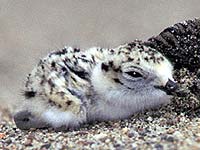 National Public Radio has a streaming story available for download that details how the Western snowy plover, Charadrius alexandrinus nivosus (pictured), a bird on the threatened species list, may lose their protected status if Bush's plan to revise the Endangered Species Act is approved. [mp3/podcast].
National Public Radio has a streaming story available for download that details how the Western snowy plover, Charadrius alexandrinus nivosus (pictured), a bird on the threatened species list, may lose their protected status if Bush's plan to revise the Endangered Species Act is approved. [mp3/podcast].Another streaming National Public Radio broadcast on All Things Considered, reveals that an apparent increase in eagle poaching in the Northwest has drawn attention to the market for eagle feathers and talons -- both legal and illegal. [mp3/podcast].
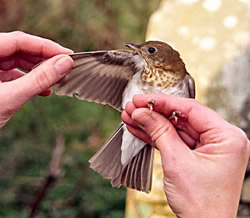 Birdwatchers were disappointed when an American thrush that landed in Shetland after being blown thousands of miles off course was killed by a cat. They believe the bird, called a Veery, Catharus fuscescens (pictured), was swept across the Atlantic during its migration from North American forests to South America for the winter. "These birds are here because they are getting caught up in the strong westerly winds coming across the Atlantic and they are being blown off course. We have had quite a few American warblers in the last few weeks." Twitchers managed to trap the veery after it was spotted at Northdale, Unst, on September 22 and ring (place a numbered band on) one of its legs. The following morning they were horrified to find the songbird had been caught and killed by a marauding pet cat. Derek Shaw, of Shetland's Bird Observatory, said: "This sighting was only the fifth recorded of a veery in Britain. They are extremely rare so it is sad that it wasn't around for a bit longer."
Birdwatchers were disappointed when an American thrush that landed in Shetland after being blown thousands of miles off course was killed by a cat. They believe the bird, called a Veery, Catharus fuscescens (pictured), was swept across the Atlantic during its migration from North American forests to South America for the winter. "These birds are here because they are getting caught up in the strong westerly winds coming across the Atlantic and they are being blown off course. We have had quite a few American warblers in the last few weeks." Twitchers managed to trap the veery after it was spotted at Northdale, Unst, on September 22 and ring (place a numbered band on) one of its legs. The following morning they were horrified to find the songbird had been caught and killed by a marauding pet cat. Derek Shaw, of Shetland's Bird Observatory, said: "This sighting was only the fifth recorded of a veery in Britain. They are extremely rare so it is sad that it wasn't around for a bit longer." People Helping Birds
 California condors, Gymnogyps californianus, are expected to return soon to the skies over San Diego County, nearly a century after they disappeared. Scientists say condors released in Mexico three years ago have made exploratory flights within 15 miles of the United States, and they believe the birds will cross the border in the next few months. "I thought it would be several years from now," said Mike Wallace, a team leader with the California Condor Recovery Program. The condor is North America's biggest bird, with wingspans up to 9 feet. It could once be found from coast to coast, but hunting, pesticides and so-called "development" drove the birds to the brink of extinction. GrrlScientist note: "development" is a socially-approved word for human-caused habitat destruction.
California condors, Gymnogyps californianus, are expected to return soon to the skies over San Diego County, nearly a century after they disappeared. Scientists say condors released in Mexico three years ago have made exploratory flights within 15 miles of the United States, and they believe the birds will cross the border in the next few months. "I thought it would be several years from now," said Mike Wallace, a team leader with the California Condor Recovery Program. The condor is North America's biggest bird, with wingspans up to 9 feet. It could once be found from coast to coast, but hunting, pesticides and so-called "development" drove the birds to the brink of extinction. GrrlScientist note: "development" is a socially-approved word for human-caused habitat destruction.Bird Flu News
Strains of avian influenza that have low pathogenicity circulate in wild birds, especially waterbirds, usually at low levels. These strains cause either mild or no symptoms. However, strains of the H5 and H7 subtypes can occasionally become highly pathogenic following a specific mutation. These highly pathogenic viruses can cause great mortality in domestic poultry flocks but are very rare in wild birds, with only one recorded instance prior to 1997 when the current strain of concern, H5N1 appeared. Cornfirming what I had long suspected, new genetic evidence clearly points to H5N1 originating in domestic birds after mutations of one or more low pathogenicity strains of avian flu. Subsequently, the very virulent H5N1 has been passed from poultry to wild birds on several occasions, and as the disease spreads, these instances are likely to become more frequent. Transmission is promoted in domestic flocks due to the density of birds and the consequent close contact with fecal and other secretions that contain the virus. Husbandry methods like those in SE Asia, where domestic flocks are often allowed to mix freely with wild birds, especially waterfowl, make the transmission to migratory waterbirds easier. In view of this information, BirdLife has published their position statement regarding avian influenza. It makes for very interesting reading.
Fears that H5N1 bird flu has reached Europe intensified this week with apparent outbreaks in Turkey and Romania. It will not be clear for several days whether the outbreaks are avian influenza, and if so, whether it is the same H5N1 strain that has spread across east Asia and killed at least 65 people. But scientists caution that Europe’s free-range poultry could be putting the continent at risk. We expect a sample from Turkey today,” VLA spokesman Matt Conway said. It will take 48 hours to confirm if the virus is the “Z genotype” H5N1 circulating in Asia. GrrlScientist comment: considering how many wild birds will die from this pandemic before it makes the jump into humans, I think we should carefully reconsider the ignored costs from free-range poultry to wild bird populations around the world. The fact that people refuse to see and consider this damage is the real tragedy in this outrageous situation. As such, one can easily recast this entire subsection as a specially hideous case of "People Hurting Birds".
Michael Osterholm, an infectious disease expert who has been studying the risk of pandemic flu for decades and is a US government adviser, said governments should be preparing to cope with the pandemic instead of relying entirely on the hope of using vaccines and drugs to control it. If the H5N1 avian flu begins to easily infect humans, it will move too quickly for drugs and vaccines to be of much use, Osterholm said. "We have had a pandemic flu plan as a planning process since 1976," said Osterholm. "Nobody has completed it. It been one of the most long-standing incompleted processes in Washington. Nobody wants to believe that modern medical science can't handle something."
As they say, knowledge is power: Do you want to learn more facts about H5N1 "bird flu"? Additionally, here is a chronology in the Asian bird flu outbreak.
Streaming Birds
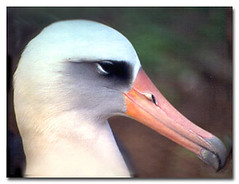 Turn up the volume to enjoy some spectacular photographs of one of my favorite ecosystems in the world. "Hawai'i's Outer Kingdom" segment is particularly well-done. They also have some lovely footage of Laysan albatross, Phoebastria immutabilis (pictured at left), and black-footed albatross, Phoebastria nigripes (pictured at top).
Turn up the volume to enjoy some spectacular photographs of one of my favorite ecosystems in the world. "Hawai'i's Outer Kingdom" segment is particularly well-done. They also have some lovely footage of Laysan albatross, Phoebastria immutabilis (pictured at left), and black-footed albatross, Phoebastria nigripes (pictured at top). Featured this week on BirdNote are answers to those Burning Bird Questions that keep you awake at night; satellite tracking of Northern Pintails, Anas acuta; the Black-footed Albatross, Phoebastria nigripes, a graceful giant (pictured at top); Merlin, Falco columbarius!; the Silly Willow Ptarmigan, Lagopus lagopus; and the Clark's Nutcracker, Nucifraga columbiana, Bird of the Northwest. BirdNote shows are two-minute vignettes that incorporate the rich sounds of birds with stories that illustrate the interesting -- and in some cases, truly amazing -- abilities of birds. Some of the shows are Pacific Northwest-oriented, but many are of general interest. Each story is accompanied by a photograph on the BirdNote site. BirdNote can be heard Monday through Friday, 8:58-9:00AM, throughout Western Washington and Southwest British Columbia and is also available as RSS/Podcast feeds. All episodes are available in the BirdNote archives, both in written transcript and mp3 formats, along with photographs. [mp3/podcast].
Miscellaneous Birds
Buddy and Becky York tell of a deathbed promise fulfilled in this touching story about a true albino hummingbird (includes a picture).
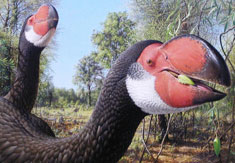 Demon Ducks of Doom? The skeleton of one of the largest birds that ever lived has been installed at the Burke Museum at the University of Washington in Seattle. The museum is acquiring a cast of the fossil bird, known as Dromornis stirtoni (pictured at left), and it will be the first one ever displayed in the United States. Over nine feet tall, Dromornis stirtoni roamed central Australia more than 8 million years ago. Mihirungs, the common name for this group of extinct birds, is an Aboriginal word meaning giant emu. Mihirungs were a unique group of Australian flightless birds also known as “thunderbirds” and were derived from early waterfowl (ducks, geese, and swans). The last of their kind became extinct about 30,000 years ago. This Dromornis cast, mounted in a dramatic running posture, is a gift to the Burke Museum from Hugh Ferguson.
Demon Ducks of Doom? The skeleton of one of the largest birds that ever lived has been installed at the Burke Museum at the University of Washington in Seattle. The museum is acquiring a cast of the fossil bird, known as Dromornis stirtoni (pictured at left), and it will be the first one ever displayed in the United States. Over nine feet tall, Dromornis stirtoni roamed central Australia more than 8 million years ago. Mihirungs, the common name for this group of extinct birds, is an Aboriginal word meaning giant emu. Mihirungs were a unique group of Australian flightless birds also known as “thunderbirds” and were derived from early waterfowl (ducks, geese, and swans). The last of their kind became extinct about 30,000 years ago. This Dromornis cast, mounted in a dramatic running posture, is a gift to the Burke Museum from Hugh Ferguson.Thanks to my bird pals, Ken, Ellen, Mike, Ian, Caren and Ron for some of the links you are enjoying here.
Previous : : Birds in the News : : Next
© 2004, 2005, 2006 by GrrlScientist











7 Peer Reviews:
Well, I must say, the albino hummingbird could almost make me a believer. What a lovely story!
I was hoping someone qualified would mention the Feduccia article. This makes me wonder if these things are conscious decisions to save a pet hypothesis, or can even trained scientists fall to unwitting self-deception? I wonder the same thing about the lovely Richard Dawkins.
Ironic - another bird-like dinosaur was just discovered in South America.
Oops
Oops again, you also linked to that. I'm a mooron.
Another good issue, Hedwig. Sad news about the veery getting blown all that way just to get eaten by a cat. *sigh*
re: bird flu
Remember that the reason bird flu is a pending pandemic isn't because of free range chickens...it's the confinement operations, with thousands of birds of degraded disease resistance packed in close quarters that made this disease so virulent.
Free range flocks also won't be any larger of a vehicle for spreading the disease than the large operations. It's an easy step to go from migratory duck -> starling/house sparrow -> confinement chickens. (and all confinement operations I've seen are awash in starlings and house sparrows) The slightly shorter step of migratory bird -> free range chicken can happen, but the free range birds have a far greater resistance to disease (generally)
2 cents, from a farmer/ornithologist
Rich
www.mossbackfarm.com
Tabor; I actually found a few more pictures of the bird on the web and they are lovely. I was not able to obtain permission in time to use them here, otherwise, you would be ooohing and aaaahing over them now.
Jamie; I am not sure if this is a conscious decision or not, but it is certainly understandable: can you name another field (outside of science) where an entire lifetime of work is shown to be wrong in the span of between a few minutes to a few years?
Trix; yes, sad indeed.
Anonymous; oh, I am well aware that the source of the "bird flu" is the poultry monoculture that humans love to grow, and I have ranted about this more than once on this blog. I thought that including that rant again was getting rather redundant, so I left it out.
GrrlScientist
Post a Comment
<< Home